In recent years you may have noticed several news stories about botched art restorations, the most famous of these sparking both humour and debate about ethics and how best to protect historic paintings and sculptures. Many of these disasters could have been avoided if a professional conservator had been appointed, especially as many of the issues surrounding these artworks come from the overzealous attempts of amateaur artists. The application of new paint is the most common mistake, one which obscures or at worst destroys the original in a misguided attempt to preserve it.

Our conservators work in accordance with academic principles and museum-level training, which means that only the minimum interference will ever be undertaken in order to protect the integrity of the artwork. With this in mind, our team would like to share with you their opinion on how these famous botched restorations could have been prevented through accurate treatments and techniques.
Ecce Homo by Elías García Martínez
This is possibly the most famous restoration gone wrong, in which Ecce Homo / “Behold the Man ” turned into Ecce Mono / “Behold the Monkey”. The disaster was due to the good intentions of an elderly parishioner who had attempted to revive a damaged fresco in 2012. At first, many thought that this may have been an act of vandalism, as the results were so shockingly different, but it soon came to light that the 81 year old had begun working on the piece due to the damage and flaking which was occurring to the surface paint.
 Above: the process of Ecce Homo deteriorating followed by the ‘Monkey Christ’ restoration attempt
Above: the process of Ecce Homo deteriorating followed by the ‘Monkey Christ’ restoration attempt
Ecce Homo is located in the Sanctuary of Mercy church in Borja, Spain and was originally painted by Elías García Martínez in 1930. It has now been so drastically altered that many can no longer say it is the work of the same artist, but instead a piece by Cecilia Giménez after Martínez. The concept of Ecce Homo comes from the words used by Pontius Pilate in a translation of the Gospel of John, just as Christ is presented to the crowd with his crown of thorns. Famous depictions of this scene can be found throughout art history, including in work by Caravaggio and Titian. It is a gripping and pious scene in the lead up to the crucifixion, in which Christ shows strength in devotion during immeasurable pain. In the original fresco, Martínez depicts this through the careful facial expression and upward gaze. The depletion of these details under a new coat of inappropriate paint have also removed the religious context and message.
 Above: a close-up of the Ecce Homo restoration attempt
Above: a close-up of the Ecce Homo restoration attempt
Although it was not a globally important artwork, it did form part of the local history and had significance for those worshipping. However, some say that this botched repair has been beneficial for the town and the church, who received over 130,000 new visitors by 2015 to view the infamous repair job.
How would a professional have restored Ecce Homo?
Although the most striking issue with the Ecce Homo restoration is the overpainting, it should also be considered that the original flaking and deterioration of the painting has not been entirely resolved. This is the first point our trained conservators would focus on, as the consolidation of these original paint flakes would help to preserve the artwork going forwards, whilst not needing to take away any layers of original paintwork. In fact, our team always asks that all flakes of a painting, no matter how small, should be kept to one side, as they can replace these during the restoration process, thus maintaining as much artistic integrity as possible.
Above: our conservators injecting consolidation fluid behind cracks in a victorian ceiling painting
The flaking paint is not only readhered, but any loosening or cracked areas will also be secured with small injections of conservation appropriate adhesive under the surface. This is always tested for the type of materials, including the wall itself and the paint layer, to ensure that it will be safe and stabilised for years to come. It is only after these steps have been performed that the painting is sensitively cleaned and finally retouched with expert precision and colour-matching to exact areas which require this.
 Above: conservation solution being injected in our studio, this will stabilise the area and prevent further loss
Above: conservation solution being injected in our studio, this will stabilise the area and prevent further loss
The original fresco was flaking due to the environment of the church and the fluctuation of heat and humidity on the church walls. Our team would have also advised solutions to stabilise this, or encouraged routine maintenance to ensure such a drastic repair is not required again.
The Immaculate Conception of Los Venerables by Bartolomé Esteban Murillo
Murillo is one of the most well known artists of the Spanish baroque period, as well as romantic scenes of women and children, his paintings of the Virgin Mary are renowned for their beauty and ethereal themes. The Immaculate Conception of El Escorial is perhaps his most famous depiction, now housed in Madrid’s Museo del Prado, and it was a copy of this artwork which in 2020 received a less than sympathetic restoration.
 Above: the process of the restoration from what the original would have looked like, through to the first and second amateur attempts at retouching the face
Above: the process of the restoration from what the original would have looked like, through to the first and second amateur attempts at retouching the face
The original Immaculate Conception of El Escorial displays a bright and heavenly scene, with the Virgin surrounded by rolling clouds, cherubs and celestial moon beneath her feet. The most striking feature is the Virgin’s gentle facial expression as her gaze lifts upwards in prayer. This painting may have been partially inspired by a description of the ‘woman of the apocalypse’ as featured in the book of revelation, adding to the meaning of the symbols and analysis of the piece. Overall, this artwork is renowned for its grand feeling of weightlessness and purity. The Immaculate Conception of Los Venerables would have captured the same complexity before the restoration took place, unfortunately important features such as the Virgin’s gaze were lost in the process.
 Above: The original Immaculate Conception of El Escorial by Bartolomé Esteban Murillo
Above: The original Immaculate Conception of El Escorial by Bartolomé Esteban Murillo
The painting had an attempted restoration, not once but twice. The painting belonged to a private collector who called on the services of a local furniture restorer to complete the task, leading to a complete overpainting of the features, most notably the face which became completely obscured and given bright red lips. A second attempt was made, but this only made the painting worse as much of the original was then lost. This story led to a call for regulations in the art conservation industry in Spain, as it followed not long after the Ecce Homo saga from 2012.
How would a professional have restored The Immaculate Conception of Los Venerables?
Although some may like to think a skill for repairing antiques is transferable, our furniture experts would never attempt to clean an oil painting, nor would our painting conservators attempt furniture repairs. All aspects of artwork and decorative items have their own needs, the amount of knowledge required for this is outstanding. It is not often that any trained conservator will work outside of their field, due to the need to be an expert in the materials and complexities of just one area such as paper, ceramics, or oil paintings. In the case of this restoration disaster, a furniture restorer was paid to restore a painting, which may be the first downfall.
 Above: an oil painting being tested with tiny swabs before a surface clean in our studio
Above: an oil painting being tested with tiny swabs before a surface clean in our studio
Like Ecce Homo, the most noticeable change on this painting is the over-use of new colours which have been liberally applied to the surface. When our conservators come across an oil painting in need of restoration, their first thoughts are not for the rejuvenation of large areas, rather they focus on the stability of the piece and consider the least disruptive ways in which to resolve these issues. They will also use a UV torch to establish any areas of historic overpainting which may be disturbing the artwork or require a more sensitive approach to cleaning.
 Above: UV light showing areas of overpainting on an oil painting in our studio, this will help to guide our conservator in their treatment
Above: UV light showing areas of overpainting on an oil painting in our studio, this will help to guide our conservator in their treatment
A typical oil painting restoration involves the removal of varnish with tested solutions suitable for the painting. Historic varnish tends to discolour into a yellowish hue due to natural decay, but it may have also been contaminated with fireplace smoke or nicotine over the last few centuries or decades. Once this is removed and any treatments to stabilise the paint layer are performed, a new coat is added before any retouching takes place. This means that overpainting of lost areas is contained upon a varnish seal and not touching the original artwork. Our team ensures that all restoration work is fully reversible for both future conservators to take note of and for reasons of historic integrity and analysis.
Above: an example of the sensitive retouching of tailored pigments which a trained conservator would apply in minimal quantities
The task of retouching an oil painting does not use full, bold strokes as seen in these disasters. Instead, it is often completely with a very small paintbrush and the application with a pin-prick sized amount of pigment. The colours are also carefully colour matched. It is extremely rare that large areas need reinstating, in the case that they do our team use artistic and historical knowledge to complete these and will only carry out this work if it is important for the preservation of the artwork, eg. not allowing any uncovered canvas or ground layer to be on vulnerable display, or to add strength to the overall paint layer to avoid encouragement of flaking. The finished retouching has another layer of conservation varnish applied, and should overall not have any evidence of interruption to the original painting.
Above: the retouching of a disturbed area with precisely colour-matched pigments in our studio
16th century sculpture of St. George at the Church of San Miguel de Estella
This 500 year old sculpture was left looking like a feature of an amusement park rather than a historically significant artwork following a restoration attempt in 2018. This led to not only a badly damaged statue, but a fine of over $9,000 and a cost of $37,000 to restore it back to an near-original condition. The sculpture was made of walnut wood and the restoration attempt had contaminated it with paint and chemicals which are extremely high risk to the safe preservation of such materials, so this wasn’t just a case of bad painting, but a risk to the future of the sculpture itself.
 Above: the restoration of St. George from the original appearance through to the botched restoration and the final result from the conservation work to bring back original colours and finish
Above: the restoration of St. George from the original appearance through to the botched restoration and the final result from the conservation work to bring back original colours and finish
The original sculpture was of the Hispano-Flemish gothic style, the original artist had used a polychrome technique. Spanish sculptors of the era could only cover their pieces in white gesso and were not allowed to use bold colours, they were instead completed by a different artist. Much of the original intact paintwork was completely lost following the restoration attempt by a local teacher who was untrained in art conservation. They had sanded down the sculpture and applied layers of plaster to the surface, erasing any historical evidence. Sadly, the remains of natural pigments would have been important to historians in gaining an insight into a period of trade, manufacturing and art, under a microscope you can learn where these colours would have come from and how they might have been produced.
 Above: The full St. George sculpture before and after the bad restoration being removed and returned to a safe and historically accurate finish
Above: The full St. George sculpture before and after the bad restoration being removed and returned to a safe and historically accurate finish
How would professionals restore the sculpture of St. George?
Following the disaster, a new team was brought in to restore the statue back to its original state, this time it was a set of professional conservators who carefully tested the artwork and took samples to ensure they had the most appropriate way of cleaning and preserving it. This also included x-rays to find areas of the original paintwork, in hopes of rescuing it beneath the new layers of plaster and paint. In 2019 it was due to be returned for display, this time with less garish colours and a more appropriate restoration in keeping with the historical nature of the sculpture.
 Above: examples of terracotta restoration in our studio, the breakages were restored due to putting the artwork at risk, but paintwork remains intact as retouching it would not be appropriate for the preservation
Above: examples of terracotta restoration in our studio, the breakages were restored due to putting the artwork at risk, but paintwork remains intact as retouching it would not be appropriate for the preservation
The mistakes made in this restoration stem from the idea that the repair of an artwork or sculpture requires a complete overhaul of the appearance and reinstatement of colour from a contemporary perspective. This untrained approach is misguided, as it forgets the importance of all aspects, from the small details of remaining colour through to the sensitive nature of a historical item. A trained conservator will only ever use sensitive treatments which do not disturb the ongoing preservation of a material, as well as maintaining historic and artistic integrity – even if this means that some lost areas of paint remain so, or some aspects of discolouration stay in place if the means to resolve this put the artwork in any risk. All treatments are tested and performed with a well rounded view of the historic nature of an artwork, the chemical nature of the materials, and the ongoing stability for safe preservation – rather than purely the vivid tones of the paintwork.
 Above: historic pigments should not be removed or covered as they have their own part to play in historic analysis
Above: historic pigments should not be removed or covered as they have their own part to play in historic analysis
How can we help?
Our team restores all artworks with conservation appropriate treatments, all of our team have training to Masters level and beyond, including some with ICON accreditation. They are all experts in their own field, but can collaborate when it comes to mixed media or a wider collection of artworks in need of preservation. As well as professional restoration, our conservators can also work to reverse botched or failing restoration attempts, reinstating the original artwork as much as is safe and possible to do so.
If you have an artwork which you would like to have restored, or would like advice following the discovery of an amateur restoration gone wrong, please speak to our helpful team who will be happy to assist you further.
To make contact please email us via [email protected] or call 0207 112 7576

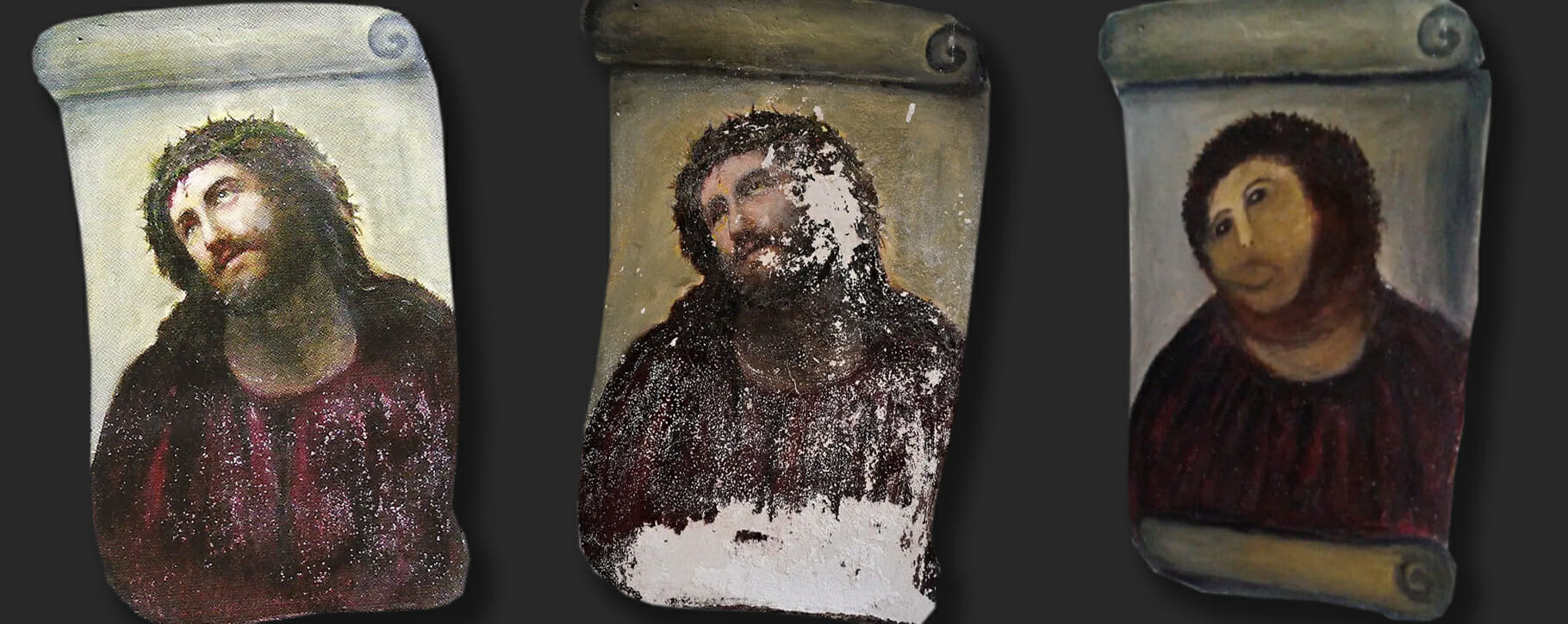 Above: the process of Ecce Homo deteriorating followed by the ‘Monkey Christ’ restoration attempt
Above: the process of Ecce Homo deteriorating followed by the ‘Monkey Christ’ restoration attempt 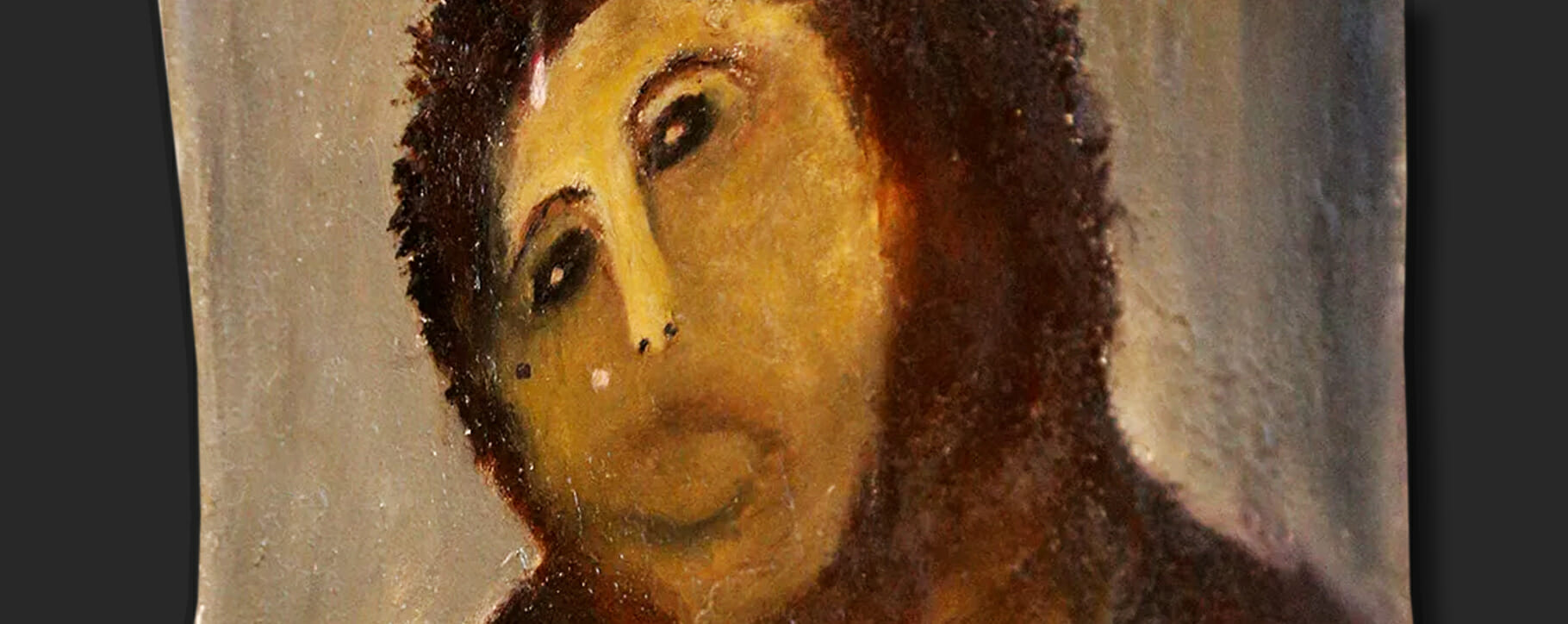 Above: a close-up of the Ecce Homo restoration attempt
Above: a close-up of the Ecce Homo restoration attempt Above: conservation solution being injected in our studio, this will stabilise the area and prevent further loss
Above: conservation solution being injected in our studio, this will stabilise the area and prevent further loss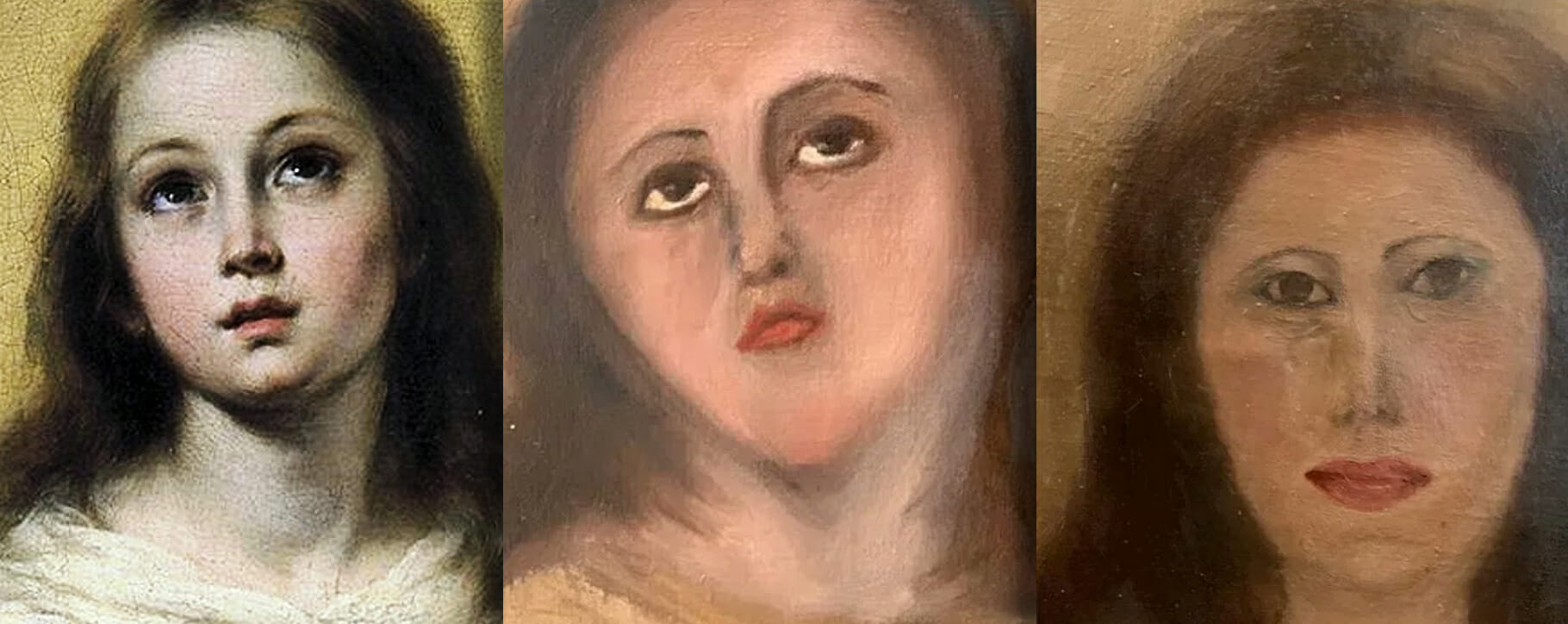 Above: the process of the restoration from what the original would have looked like, through to the first and second amateur attempts at retouching the face
Above: the process of the restoration from what the original would have looked like, through to the first and second amateur attempts at retouching the face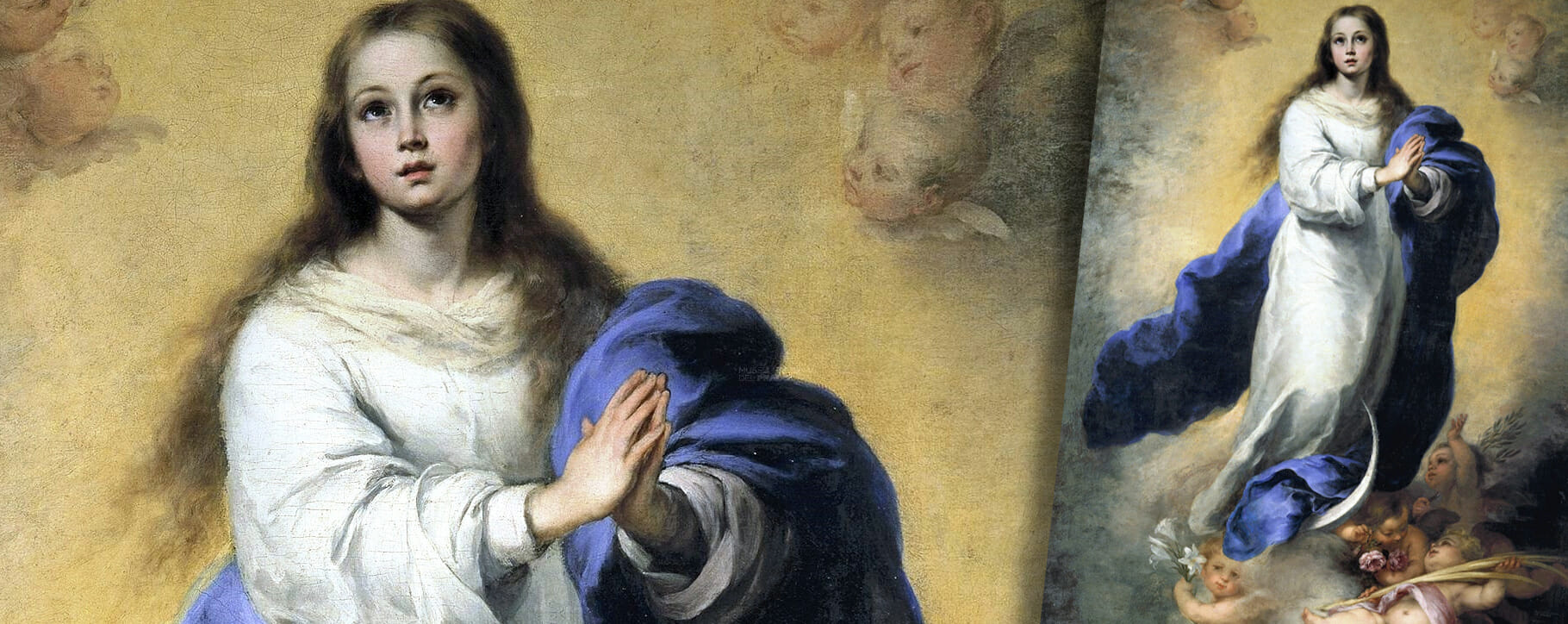 Above: The original Immaculate Conception of El Escorial by Bartolomé Esteban Murillo
Above: The original Immaculate Conception of El Escorial by Bartolomé Esteban Murillo Above: an oil painting being tested with tiny swabs before a surface clean in our studio
Above: an oil painting being tested with tiny swabs before a surface clean in our studio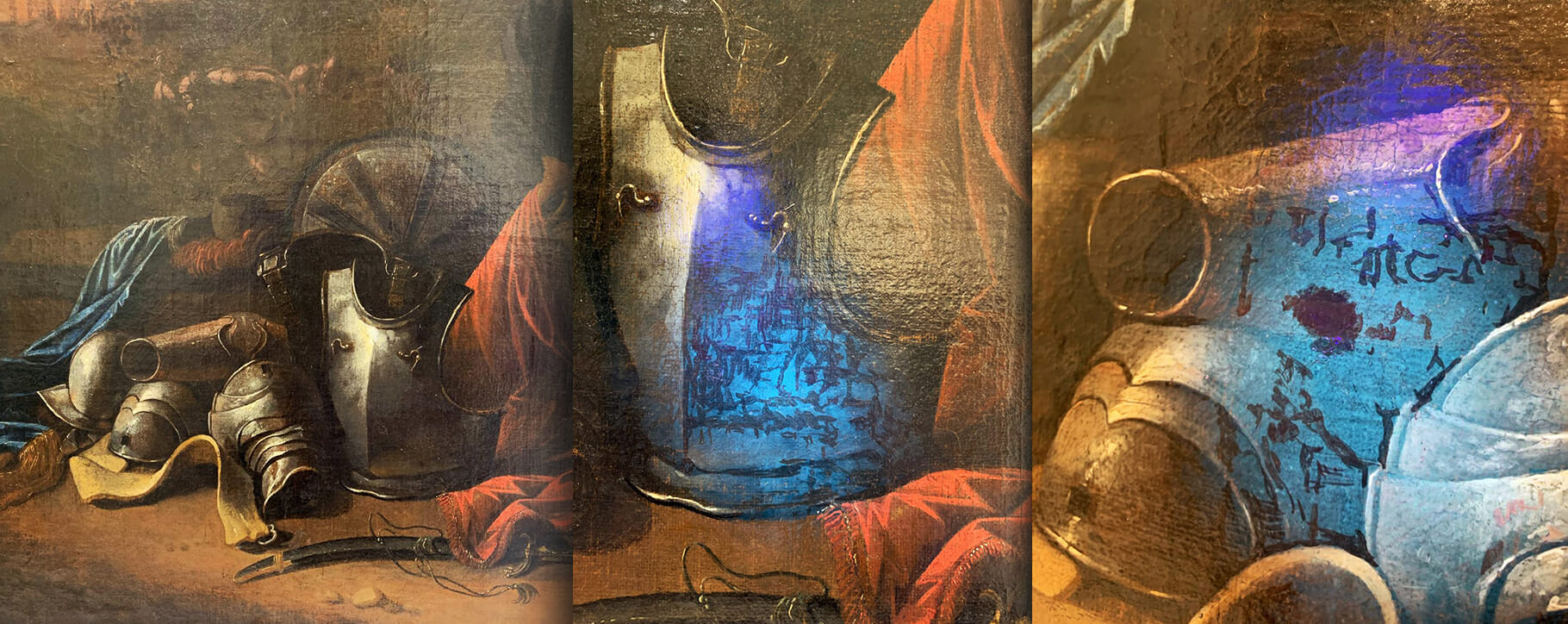 Above: UV light showing areas of overpainting on an oil painting in our studio, this will help to guide our conservator in their treatment
Above: UV light showing areas of overpainting on an oil painting in our studio, this will help to guide our conservator in their treatment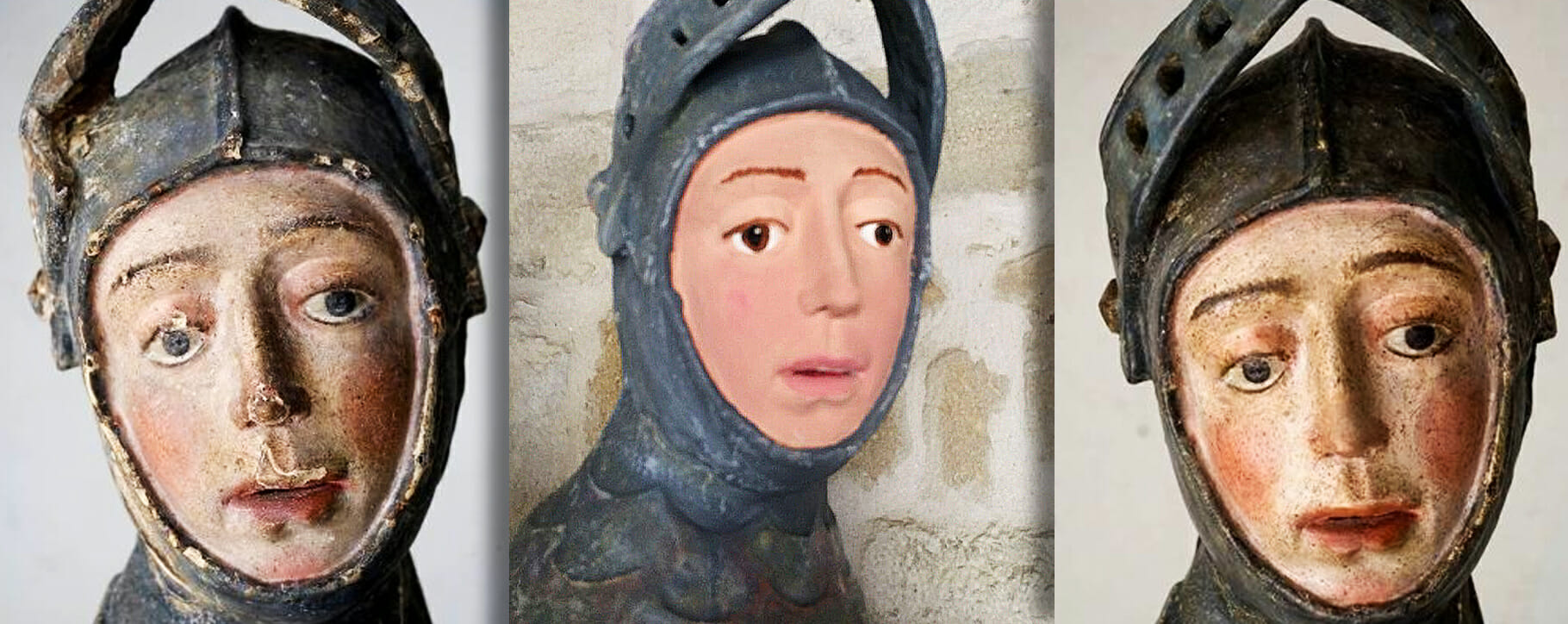 Above: the restoration of St. George from the original appearance through to the botched restoration and the final result from the conservation work to bring back original colours and finish
Above: the restoration of St. George from the original appearance through to the botched restoration and the final result from the conservation work to bring back original colours and finish 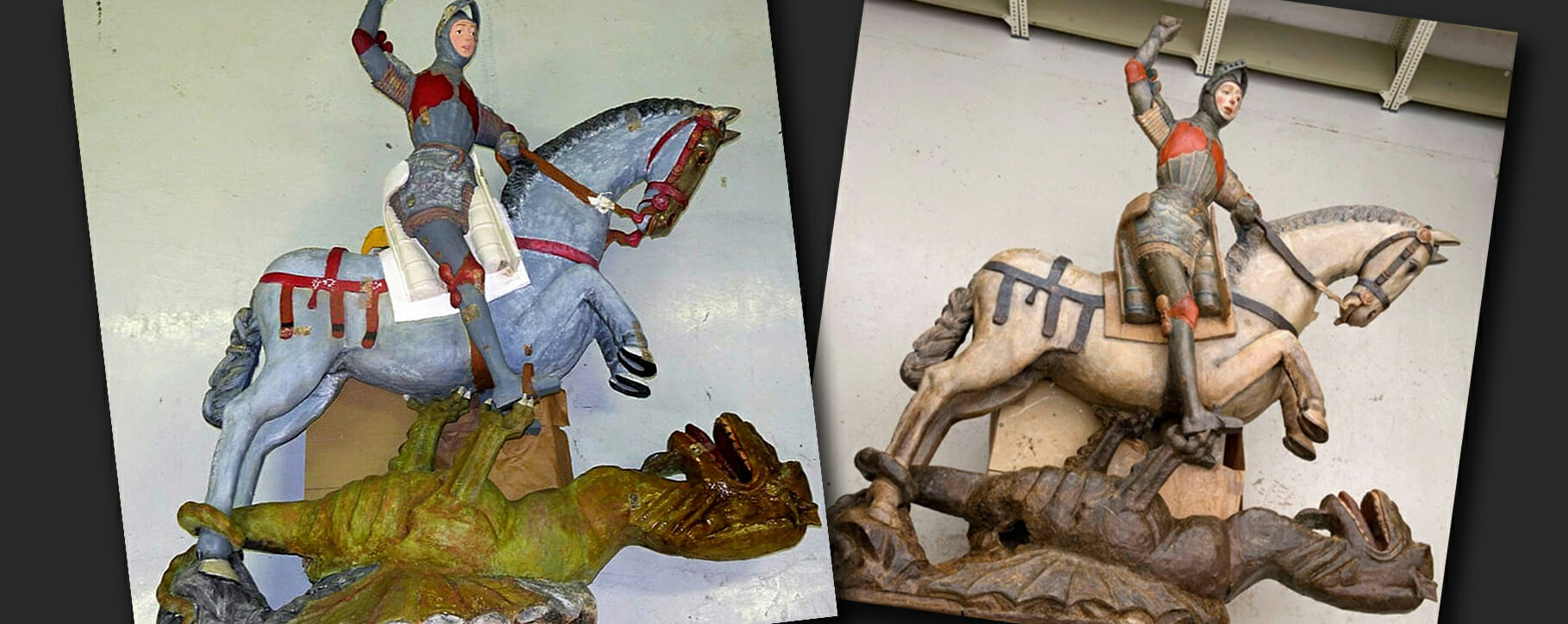 Above: The full St. George sculpture before and after the bad restoration being removed and returned to a safe and historically accurate finish
Above: The full St. George sculpture before and after the bad restoration being removed and returned to a safe and historically accurate finish Above: examples of terracotta restoration in our studio, the breakages were restored due to putting the artwork at risk, but paintwork remains intact as retouching it would not be appropriate for the preservation
Above: examples of terracotta restoration in our studio, the breakages were restored due to putting the artwork at risk, but paintwork remains intact as retouching it would not be appropriate for the preservation 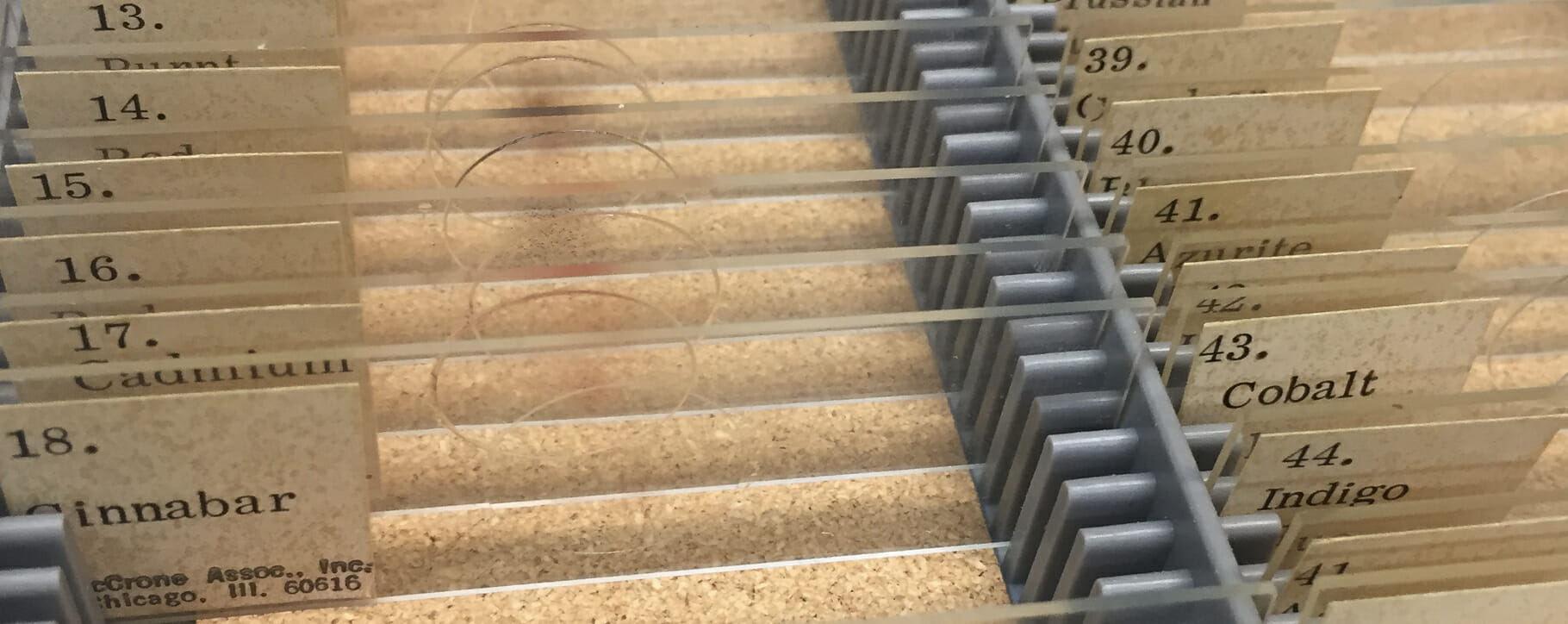 Above: historic pigments should not be removed or covered as they have their own part to play in historic analysis
Above: historic pigments should not be removed or covered as they have their own part to play in historic analysis 




